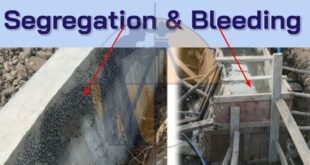Minimum Concrete Cover for Reinforcement What is Concrete Cover for Reinforcement
Concrete cover, in reinforced concrete, is the least distance between the surface of embedded reinforcement and the outer surface of the concrete (ACI 130). The concrete cover depth can be measured with a cover meter.

Different Types of Concrete Cover Block:-
There are different types of covering blocks based on the type of material used:-
1. Wooden concrete cover Block
2. Steel concrete cover block
3. PVC Block
4. Cement Masonry concrete cover block
5. Aluminum Block
6. Stones
Learn More
Basic Components of Building Structure | Building Elements | Sub Structure | Super Structure
Minimum Concrete Cover for Reinforcement:
Below are the specifications for reinforcement cover for different structural members in different conditions.
- At each end of the reinforcing bar, concrete cover not less than 25 mm or less than twice the diameter of the bar should be provided.
- For a longitudinal reinforcing bar in a column, concrete cover not less than 40 mm not less than the diameter of such a bar should be provided. In the case of columns of the minimum dimension of 20 cm or under, whose reinforcing bars do not exceed 12 mm, the concrete cover of 25 mm to be used for reinforcement.
- For longitudinal reinforcing bars in a beam, not less than 30 mm or less than the diameter of the bar.
- For tensile, compressive shear or other reinforcements in a slab or wall not less than 15 mm, not less than the diameter of such a bar.
- For any other reinforcement not less than 15 mm, concrete cover not less than the diameter of such a bar.
- For footings and other principal structural members in which the concrete is deposited directly against the ground, cover to the bottom reinforcement shall be 75 mm. If concrete is poured on a layer of lean concrete, the bottom cover may be reduced to 50 mm.
- For concrete surfaces exposed to the weather or the ground after removal of forms, such as retaining walls, grade beams, footing sides, and top, etc. cover should not be less than 50 mm.
- Increased cover thickness shall be provided as indicated on the drawings, for surfaces exposed to the action of harmful chemicals (or exposed to earth contaminated by such chemicals), acid, alkali, saline atmosphere, sulfur, smoke, etc.
- For liquid retaining structures, the minimum cover to all-steel shall be 40mm or the diameter of the main bar, whichever is greater. In the presence of seawater and oils and waters of a corrosive character, the covers shall be increased by 10 mm.
- Protection to reinforcement in case of concrete exposed to harmful surroundings may also be given by providing a dense impermeable concrete with approved protective coatings. In such a case the extra cover mentioned in (b) & (i) above may be reduced.
- The correct cover shall be maintained by cement mortar cubes (blocks) or other approved means. Reinforcements for footings, grade beams, and slabs on a sub-grade shall be supported on precast concrete blocks as approved by EIC. The use of pebbles or stones shall not be permitted.
- The minimum clear distance between reinforcing bars shall be in accordance with IS:456 – 2000 or as shown in the drawing.
Learn More
-
-Concrete Test: Slump test, compression test, split tensile test, soundness etc.
-
-Soil Test: Core cutter test, compaction test, sand replacement test, triaxial test, consolidation test etc.
-
-Bitumen Test: Ductility test, softening point test, gravity test, penetration test etc.
 Surveying & Architects A unique platform of Civil Engineering
Surveying & Architects A unique platform of Civil Engineering
